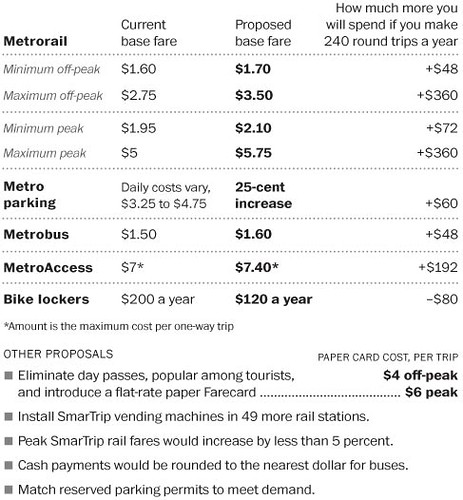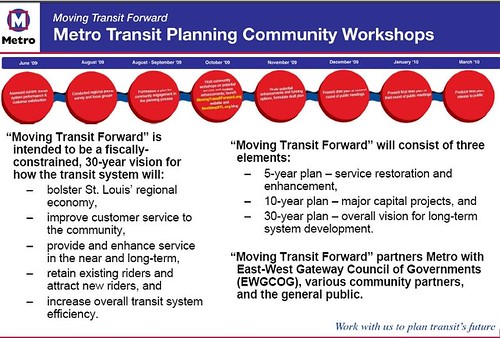Proposed WMATA fare increases (DC region)

Slide from my presentation, Metropolitan Mass Transit Planning: Towards a Hierarchical and Conceptual Framework.
Pressed once again to make budget projections, WMATA has proposed transit fare increases for the 2012-2013 fiscal year. See "Proposed Metro budget that would raise fares calls for hiring of 1000 workers" and "Metro board considers fare proposal, next budget" from the Washington Post.

Graphic from the Washington Post.
One of the proposals is to get rid of the $9 all-day pass, which is designed to meet the needs of visitors, and instead only offer the use of temporary subway fare cards--single purchase fare cards purchased for one time use--at rates comparable to the cost of a railroad train ride, rather than a typical in-region transit trip on subway, light rail, or bus.
The rates would change to $6 one way for a trip during rush periods, and $4 during nonrush periods. By way of example, $6 is how much MARC charges for travel to DC from the BWI Airport, 30 miles away (although that fare is going up too).
This changes the pricing scheme significantly, and makes ridership uneconomic for many people, especially groups. Why pay $18-$24 for a group of four to travel one way when you can just drive? Paying for parking in a parking structure for an entire day costs about this much or less, and wouldn't trigger a similar cost driving back. Or taxi rides become more competitive price-wise, etc.
Charging exorbitant rates to visitors is not an unusual revenue generating strategy for communities. It's done with hotel rooming taxes, rental car usage taxes, and parking structure taxes in many cities, and in DC particularly, the tax on restaurant meals--10%--is much higher than in other places, in large part because of the belief that more of the tax is paid for by nonresidents than residents.
Typically, most of these taxes are used to support convention centers, tourism marketing, and related activities, although parking taxes tend to be a general fund revenue item.
So there is a precedent for looking to tag visitors with exorbitant prices to use the subway system, which already charges more for casual users versus SmarTrip card users.
• Is the transit system supposed to be used to get people to and from work, ideally where the workers have subsidized transit benefits (e.g., federal government workers are eligible for free transit benefits worth about $125/month)?
• Is the transit system supposed to be used as a mobility congestion management tool to reduce traffic and the need to build and maintain more roadways?
• Is the transit system seen as an element of a community's positioning and economic development strategy, shaping land use in sustainable ways so that the need to travel is reduced by placing more activities within walking, biking, and transit distance?
• Should a fare system be developed that supports the creation of "fare zones" and passes, so that transit use is encouraged, rather than discouraged, in terms of the cost of any one trip; etc.,
These kinds of issues are discussed in the past blog entry "(Sort of a repeat) Without the right transportation planning framework, metropolitan areas are screwed, and that includes the DC area."
For the region, consideration of the transit system as the primary element of civic and transportation infrastructure within the region, as the leading means for shaping mobility and land use decision making, congestion management, and for creating great places and promoting high quality of life is paramount.
This problem isn't unique to WMATA. Most transit operators nationally have the same kind of funding desperation because of drop off in local and state funding as a result of the recession, as well as drop offs in local tax receipts such as sales taxes and real estate transaction taxes and other taxes which have been used to support local transit operations.
In the face of region's loss of trust with regard to WMATA after the train crash in 2009, which resulted in the deaths of nine passengers, I recommended that the transit system and the region engage in a high profile transportation planning initiative focused on rebuilding the region's understanding of the role and primacy of transit as the main engine of growth, mobility, and prosperity.

Other regions have/had similar initiative's such as Chicago's Moving Beyond Congestion Strategic Plan, the Go Ohio transportation planning initiative in Ohio, and Keep PGH Moving in Pittsburgh (although that campaign is more focused on obtaining state funding for the local transit system to reduce the number of cutbacks).
While people are familiar with special local tax initiatives to support transit expansion, such as Los Angeles' Measure R, clearly the DC region--DC, Maryland, and Virginia--need to consider such initiatives as a source of funds to help get WMATA onto a new track when it comes to fares and revenue management.
-- Center for Transportation Excellence, a research group that supports transit infrastructure funding and election initiatives
-- WA State Licensing: Local transportation benefit district fees
Labels: car culture and automobility, civic engagement, neighborhood-based transportation planning, regional planning, transit and economic development, transit fares, urban design/placemaking





0 Comments:
Post a Comment
<< Home